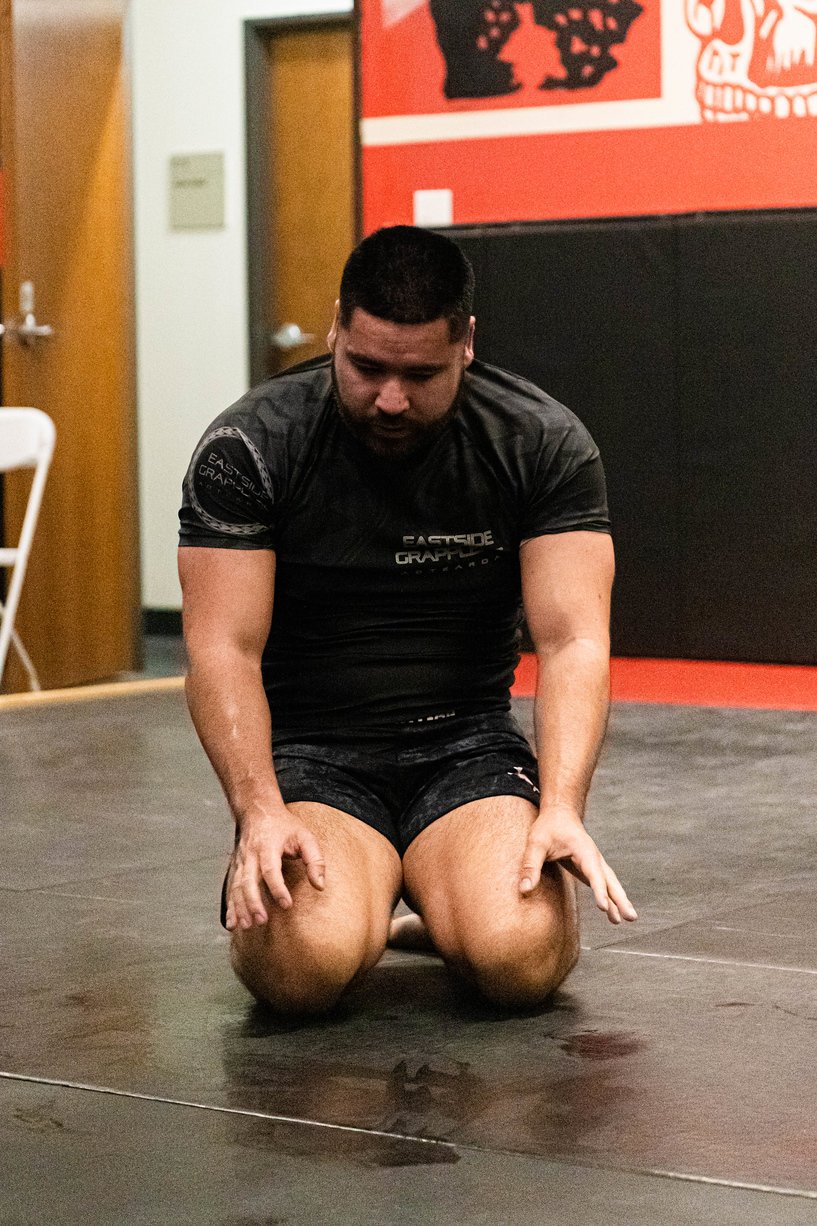As a boxing fanatic, you've likely seen most of the boxing training montages on YouTube. Watching Mike Tyson hit the pads, Muhammad Ali's training footage, and various other star's training montages filled with shadow boxing and bag work.
And these boxing workouts are intense! Perfect to add to your own boxing routine. However, copying the pros boxing workouts without knowing the what, when, and why is like throwing the proverbial sh*t at the wall and hoping one of them turns you into a boxing powerhouse.
So, rather than giving you a bunch of random boxing workouts with no real goal, I’m going to present you with 7 elite boxing workouts that will simultaneously level up your boxing skills.
Workout #1: Continuous Shadowboxing
Shadowboxing is a staple exercise among boxers of all levels. For good reason. It reinforces the technical skill of punching. Whether that’s throwing jabs, crosses, hooks, or uppercuts, you can throw them all while focusing on the correct technique without the impact of a human or heavy bag.
And you don’t even need a training partner or any equipment! All you need is enough space to throw punches so you're not destroying furniture or your hands-on brick walls.

FREE Strength & Conditioning Program To Never Gas Out In The Ring
The Workout
30-45 minutes of continuous shadowboxing at a heart rate between 130-150 BPM. Use a combination of jabs, crosses, hooks, and uppercuts. Don't forget defensive maneuvers like head movement and footwork!
The Rationale
Contrary to what you'll read from mainstream fitness magazines and websites; boxing is not predominantly an anaerobic sport. Boxing has some of the highest aerobic energy system demands out of all of the martial arts.
In fact, some elite-level boxers have aerobic energy systems close to elite triathletes. Additionally, aerobic energy system development and the amount of blood that can be pumped in one heartbeat to the working muscles are highly associated with boxing mastery [2].
Performing low intensity, steady-state shadowboxing is your ticket to level up your gas tank. This workout will stimulate adaptations to the heart that other exercises just can't do.
Mainly, it will expand one of the heart chambers so more blood can be pooled in-between each heartbeat. Guess what that allows?
You guessed it. The potential for more blood to be pumped with each heartbeat. This means more blood being delivered to the working muscles and therefore, more oxygen to continue fueling the aerobic energy system.
But the adaptations don’t stop there. There’s a reason I’ve picked shadowboxing for this workout and not roadwork.
The anaerobic threshold (the upper limit of the aerobic energy system) is reflected by the aerobic potential of the muscles involved in the task.
Meaning we can run, swim, or bike all we like to raise our upper limit of the aerobic energy system, but it won’t transfer as well to boxing compared to actually boxing to raise our anaerobic threshold.
Aerobic adaptations to the muscles occur with this type of workout where more blood vessels are created so more blood can flow through the muscle. And therefore, more oxygen can be delivered.
Workout #2: Aerobic Power Intervals On The Heavy Bag
Continuous boxing is great for expanding your gas tank. But performing aerobic intervals are another way of attacking the aerobic energy system at its limits.
While this workout uses a heavy bag, you aren’t limited to the heavy bag. You can use pads if you have a training partner or even shadowboxing. Again, any combination of jabs, crosses, hooks, or uppercuts can be used.
The Workout
2-3 x (40-sec work/20-sec rest x 10) with 2-3 minutes rest between sets. Keep heart under approximately 165-175 beats per minute. Each working interval should be done at 70% effort. Smooth and rhythmic.
The Rationale
While low-intensity aerobic workouts are great for the reasons mentioned previously, aerobic style intervals are a good change of pace and allows us to challenge the upper end of the aerobic energy system.
Further, performing an interval-style workout can be seen as being a little more "specific" to the sport of boxing as you won't be boxing for 30 minutes straight.
These aerobic power intervals will allow you to throw slightly harder punching combinations with the idea to drill quality technique and still developing aerobic qualities.
Workout #3: Continuous Boxing Circuit
Back to our continuous training. Perhaps you don’t want to shadowbox for 30 minutes straight. That’s fine. The continuous boxing circuit is for you! The continuous boxing circuit can be performed however you like.
You can split your time intervals for each exercise however you please based on the exercises you enjoy or what you need to work on. Here are the exercise options you can choose from:
- Shadowboxing
- Any bag
- Pads
- Skipping
- Medicine ball throws
- Bodyweight exercises
- Dumbbell contralateral exercises
- Band contralateral exercises
- Mobility exercises
The Workout
30-90 minutes at a heart rate between 130-150 BPM. Here is an example 60-minute circuit you can use:
- Shadowboxing – 10 minutes
- Sub-maximal medicine ball throws – 5 minutes
- Chest pass against wall x 20
- Front-facing rotational throw x 20
- Overhead throw x 20
- Side facing rotational throw x 20
- Forward scoop toss x 20
- Slam x 20
- Scoop toss x 20
- Repeat for 5 minutes
- Skipping – 10 minutes
- Bag work – 15 minutes
- Contralateral exercises – 10 minutes
- Reverse lunge with opposite arm band row x 10/side
- Step up with opposite arm band chest press x 10/side
- Single leg RDL with opposite arm DB row x 10/side
- Single leg box squat with opposite arm DB press x 10/side
- RDL with DB row x 10
- Repeat for 10 minutes
- Shadowboxing – 10 minutes
The Rationale
Sometimes, adding more boxing workouts on top of boxing technical training is a recipe for an overuse injury. As a beginner, it’s a great idea to spend as much time boxing as possible. Including your extra workouts.
For more advanced boxers, workouts outside of boxing are a good idea due to the large training loads of boxing. So, we can still gain the same aerobic adaptations as in workout one, but through different means.
Medicine ball throws and skipping are your best friends when performing these circuits. Bodyweight exercises can be sprinkled throughout the workout to add more variety and train different parts of your body.
Workout #4: Maximal Cardiac Power Workout On The Heavy Bag
These are brutal intervals. They will really test your mental fortitude to keep pushing from set to set. Ideally, you need a heavy bag to perform these properly as these are all-out intervals. It's important that you try to maintain your technique throughout the entire workout and not get sloppy as you fatigue.
The Workout
8 x 60-sec work with 2-3 minutes between reps or when your heart rate is below 120-130 BPM. Each rep must be maximal effort where you are trying to maintain your heart rate as high as possible through each interval.
The Rationale
Remember when I mentioned that the amount of blood you can pump per heartbeat is highly related to boxing mastery? Well, this is the other piece of the puzzle. The low-intensity workout was geared towards increasing the size of the heart chamber.
But what good is that if our heart isn’t strong enough to empty the chamber with each heartbeat?
This cardiac power workout on the bag is designed to improve the contractile function of the heart meaning it can contract more forcefully and is more resistant to fatigue at high heart rates.
A more forceful contraction of the heart combined with a larger heart chamber is your ticket to insane cardio.
Workout #5: Pure Power Heavy Bag Routine
Having a gas tank to finish rounds like a professional boxer is all well and good. But it’s no use if you have no power behind your punches. This heavy bag workout will develop devastating knockout power as it taps into your explosive muscle fibers.
Throw pure power shots against the heavy bag for this workout. Don’t hold anything back. But make sure you are executing technically perfect punches each time.
You may be wondering why I’m not giving you exact punching combinations to throw.
That’s because there is this simple little trick where if you choose the combinations yourself, you can throw 6-11% faster punches with 5-10% greater impact force against the bag [1].
This was studied in world-class kickboxers and the magnitude of evidence behind self-selection is strong regarding optimizing strength, speed, and power.
The Workout
2 x (6 sec work/2-3 minutes active rest x 5-6) with 5-8 minutes rest between sets. The 6 seconds of work must be maximal effort punches. The rest periods should involve very easy shadowboxing and footwork.
The Rationale
To train pure speed and power, you must train in very short, intense bursts of work with complete recovery between reps. The rest you take during this workout will seem long… too long. But there’s a reason for it.
You need this time to recover the energy you’ve used to maximize the speed and power of your next interval. The main goal is to execute each rep with the most speed and power possible and maintain this for all reps for the entire workout.
Getting better at this workout will transfer directly into improved punching power.
Workout #6: Repeat Power Heavy Bag Routine
Having knockout power is something to be feared in the ring. But it's no use if you throw your power combinations in the first rounds and no longer have the power to back them up in later rounds. Check out Canelo training on the heavy bag above.
While the aerobic workouts above will develop this skill, refining the ability to repeat power combinations can also be done on the heavy bag. The workout will be very similar to the pure power workout but with slightly extended work intervals and slightly shorter rest intervals.
The Workout
2 x (12-sec work/48-sec rest x 10) with 6-8 minutes recovery between sets. Perform light shadowboxing during the long rest between sets.
The Rationale
Having knockout power is great. But being able to repeatedly throw deadly punches is even better. While workouts one to four will be your bread and butter when it comes to throwing repeated powerful punches, this workout can add that little bit extra.
This workout will stretch the limits of your anaerobic alactic energy system developing the ability to go harder for longer and repeat this ability over and over again.
Workout #7: Lactic Burner Pad or Bag Routine
You know that burning feeling in your shoulders and arms when you box? That’s the build-up of by-products as part of the energy creation process. It sucks!
And while performing the first three workouts will help you reduce this feeling throughout a boxing match, if you are throwing a high volume of powerful punches, you’ll need something extra. That’s where this workout comes into play.
You will need to work on a bag or pads if you have a partner.
The Workout
3 x (60-sec work/90-sec rest x 3) with 6-8 minutes recovery between sets. Perform light shadowboxing between sets. Each work interval should be near maximal effort to the point where you are so gassed you don’t want to do another rep.
The Rationale
This is the icing on the cake. While all of the aerobic workouts will reduce your reliance on the anaerobic lactic energy system, you will always need the ability to tolerate lactate well especially as you start throwing combinations to finish an opponent.
The lactic burner workout is designed so you can tolerate higher levels of lactate for a given power output. This means you potentially can maintain a high level of power output at higher blood lactate levels.
It's important to note that lactate isn't the reason you fatigue or feeling that burning sensation. It's actually the build-up of waste products from metabolism. Specifically, what are known as hydrogen ions (H+).
The reason lactate or lactic acid is seen as the bad guy is that it is associated with these waste products. As in, as lactate levels rise, so do waste products. These waste products acidify the muscle which reduces its ability to contact. And therefore, reduces its ability to produce force leading to fatigue.
Being able to tolerate high levels of lactate means you can go longer under these conditions of rising lactate and by-products.
However, while not always avoidable in competition, having a well-developed aerobic energy system and a well-developed pacing strategy will mean you don’t need to dip into these anaerobic energy reserves too often.
What About Strength Workouts For Boxing?
I have extensively covered strength workouts for boxing (click on this link to see a well-designed strength program for boxing that I created) and it’s important to understand that boxing is not bodybuilding. Nor is it Powerlifting. Or any other strength sport. This means that strength workouts much be geared to making you a better boxer and that is all that matters.
Biggest, Baddest Gas Tank In Just 8 Weeks
The Dominate The Ring Conditioning System is specifically designed to develop elite level boxing cardio based on your easy to implement test results.


References
1. Halperin, I., Chapman, D. W., Martin, D. T., Lewthwaite, R., & Wulf, G. (2017). Choices enhance punching performance of competitive kickboxers. Psychological research, 81(5), 1051-1058.
2. Bruzas, V., Stasiulis, A., Cepulenas, A., Mockus, P., Statkeviciene, B., & Subacius, V. (2014). Aerobic capacity is correlated with the ranking of boxers. Perceptual and motor skills, 119(1), 50-58.


